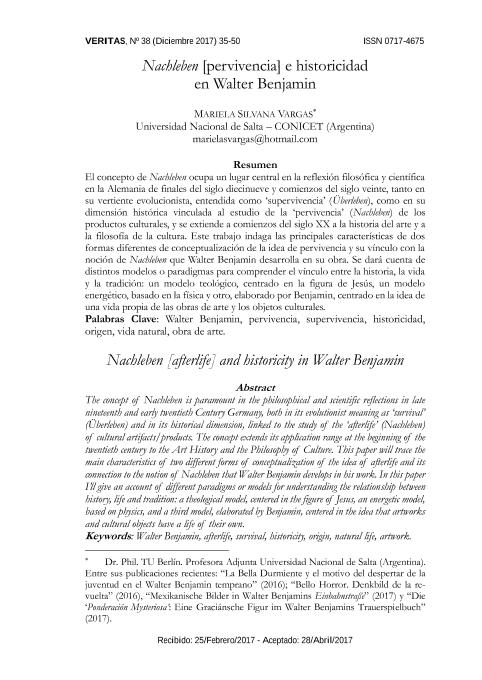Mostrar el registro sencillo del ítem
dc.contributor.author
Vargas, Mariela Silvana

dc.date.available
2018-10-05T19:26:27Z
dc.date.issued
2017-12
dc.identifier.citation
Vargas, Mariela Silvana; Nachleben [pervivencia] e historicidad en Walter Benjamin; Pontificio Seminario Mayor San Rafael; Veritas; 38; 12-2017; 35-50
dc.identifier.issn
0717-4675
dc.identifier.uri
http://hdl.handle.net/11336/61818
dc.description.abstract
El concepto de Nachleben ocupa un lugar central en la reflexión filosófica y científica en la Alemania de finales del siglo diecinueve y comienzos del siglo veinte, tanto en su vertiente evolucionista, entendida como ‘supervivencia’ (Überleben), como en su dimensión histórica vinculada al estudio de la ‘pervivencia’ (Nachleben) de los productos culturales, y se extiende a comienzos del siglo XX a la historia del arte y a la filosofía de la cultura. Este trabajo indaga las principales características de dos formas diferentes de conceptualización de la idea de pervivencia y su vínculo con la noción de Nachleben que Walter Benjamin desarrolla en su obra. Se dará cuenta de distintos modelos o paradigmas para comprender el vínculo entre la historia, la vida y la tradición: un modelo teológico, centrado en la figura de Jesús, un modelo energético, basado en la física y otro, elaborado por Benjamin, centrado en la idea de una vida propia de las obras de arte y los objetos culturales.
dc.description.abstract
The concept of Nachleben is paramount in the philosophical and scientific reflections in late nineteenth and early twentieth Century Germany, both in its evolutionist meaning as ‘survival’ (Überleben) and in its historical dimension, linked to the study of the ‘afterlife’ (Nachleben) of cultural artifacts/products. The concept extends its application range at the beginning of the twentieth century to the Art History and the Philosophy of Culture. This paper will trace the main characteristics of two different forms of conceptualization of the idea of afterlife and its connection to the notion of Nachleben that Walter Benjamin develops in his work. In this paper I’ll give an account of different paradigms or models for understanding the relationship between history, life and tradition: a theological model, centered in the figure of Jesus, an energetic model, based on physics, and a third model, elaborated by Benjamin, centered in the idea that artworks and cultural objects have a life of their own.
dc.format
application/pdf
dc.language.iso
spa
dc.publisher
Pontificio Seminario Mayor San Rafael
dc.rights
info:eu-repo/semantics/openAccess
dc.rights.uri
https://creativecommons.org/licenses/by-nc-sa/2.5/ar/
dc.subject
Pervivencia
dc.subject
Historicidad
dc.subject
Vida Natural
dc.subject
Walter Benjamin
dc.subject.classification
Estudios Religiosos

dc.subject.classification
Filosofía, Ética y Religión

dc.subject.classification
HUMANIDADES

dc.title
Nachleben [pervivencia] e historicidad en Walter Benjamin
dc.title
Nachleben [afterlife] and historicity in Walter Benjamin
dc.type
info:eu-repo/semantics/article
dc.type
info:ar-repo/semantics/artículo
dc.type
info:eu-repo/semantics/publishedVersion
dc.date.updated
2018-09-10T13:57:13Z
dc.identifier.eissn
0718-9273
dc.journal.number
38
dc.journal.pagination
35-50
dc.journal.pais
Chile

dc.journal.ciudad
Valparaiso
dc.description.fil
Fil: Vargas, Mariela Silvana. Consejo Nacional de Investigaciones Científicas y Técnicas. Centro Científico Tecnológico Conicet - Salta. Instituto de Investigaciones en Ciencias Sociales y Humanidades. Universidad Nacional de Salta. Facultad de Humanidades. Instituto de Investigaciones en Ciencias Sociales y Humanidades; Argentina
dc.journal.title
Veritas
dc.relation.alternativeid
info:eu-repo/semantics/altIdentifier/url/https://scielo.conicyt.cl/scielo.php?script=sci_arttext&pid=S0718-92732017000300035
dc.relation.alternativeid
info:eu-repo/semantics/altIdentifier/doi/http://dx.doi.org/10.4067/S0718-92732017000300035
Archivos asociados
